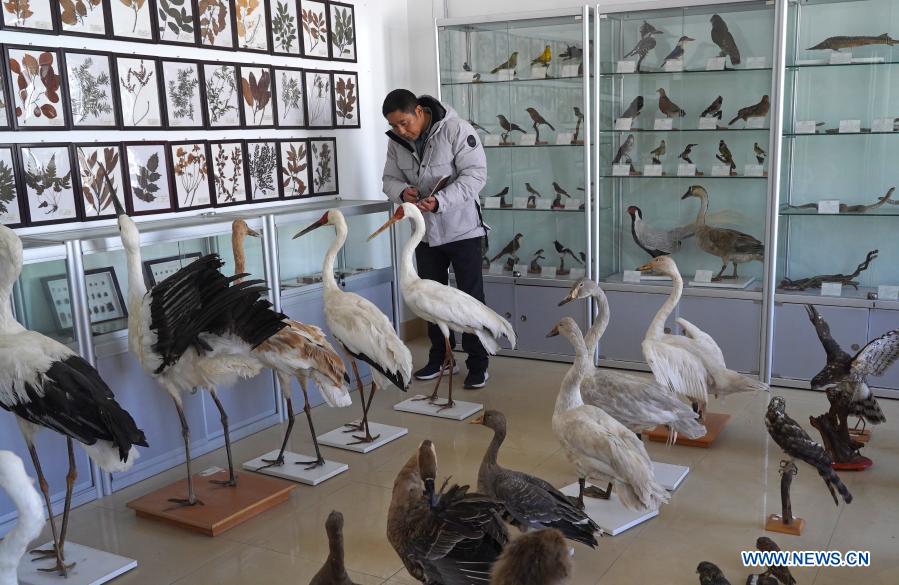
Wang Zhiru studies a white crane specimen at the Wildlife Rescue and Breeding Center in east China's Jiangxi Province, Jan. 18, 2021. Wang Zhiru, director of the Wildlife Rescue and Breeding Center of Jiangxi Province, and Kuang Shaoxiang, a veterinarian, met the white crane "Aiai" for the first time in April 2018, when it was found and sent to the center by a local villager. "When I first saw it, the crane was so dirty and couldn't even stand steadily due to long-term malnutrition." Wang Zhiru recalled. Bird lovers named the little white crane "Aiai", which means "love" in Chinese. After over 10 days of careful treatment and recuperation, Aiai recovered and could be released into the wild. However, all the other white cranes had left Poyang Lake and moved northward to Momoge National Nature Reserve in northeast China's Jilin Province. White cranes would lose their ability to survive in the wild if they were artificially reared for a long time, so the best choice was to take it to the north and released it at the destination of their migration. Wang Zhiru and Kuang Shaoxiang decided to take Aiai by plane all the way to Jilin Province, to catch up with other white cranes. "We installed a satellite tracker and made a wooden box that met aviation requirements. We also brought it with corn kernels, multivitamin water, and its favorite lotus root. It was like sending our own kid on a long trip." said Kuang Shaoxiang. After a journey of more than 2,000 kilometers from Nanchang to Changchun and then to Momoge National Nature Reserve, Aiai was finally back to the wild. The story of the crane's "family reunion" also attracted lots of attention. Unfortunately, they lost track of Aiai soon as the satellite tracker failed to send back signals, until a photographer accidentally took a picture of Aiai at the Yellow River Delta National Nature Reserve in east China's Shandong Province at the end of 2018. Seeing the "S26" tag on the crane's leg, Wang Zhiru recognized Aiai immediately. "This is Aiai and it proves that Aiai has successfully returned to life in the wild and it even has a mate by its side!" Since then, no one has ever met Aiai again, but Wang Zhiru feels no regret at all. "I'm filled with joy knowing so many people are caring about white cranes, and seeing more and more migratory birds foraging, playing and flying freely at Poyang Lake." Wang Zhiru said. (Xinhua/Wan Xiang)
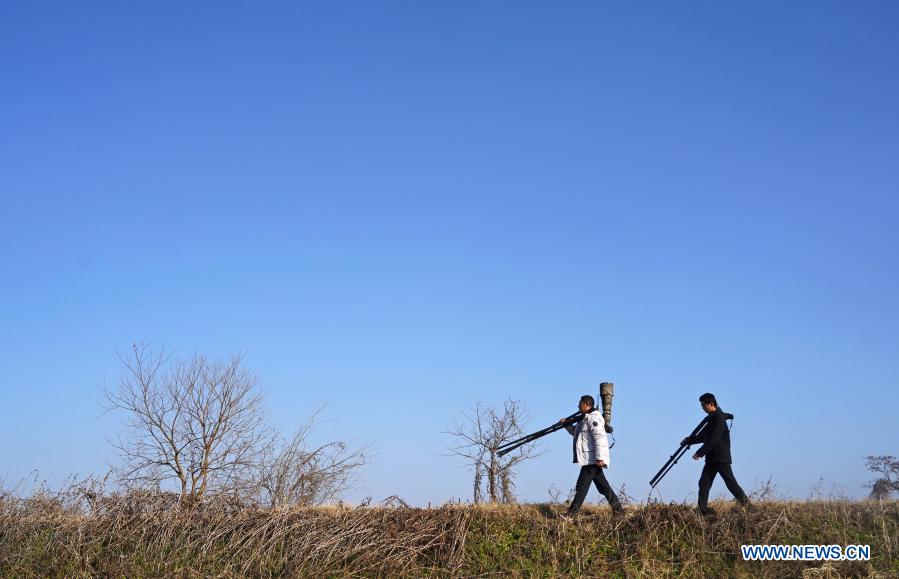
Wang Zhiru (L) and Kuang Shaoxiang are on their way to observe and photograph white cranes in the Kangshan reclamation zone, which serves as one of the birds' wintering habitats near the Poyang Lake, in Yugan County, east China's Jiangxi Province, Jan. 18, 2021. Wang Zhiru, director of the Wildlife Rescue and Breeding Center of Jiangxi Province, and Kuang Shaoxiang, a veterinarian, met the white crane "Aiai" for the first time in April 2018, when it was found and sent to the center by a local villager. "When I first saw it, the crane was so dirty and couldn't even stand steadily due to long-term malnutrition." Wang Zhiru recalled. Bird lovers named the little white crane "Aiai", which means "love" in Chinese. After over 10 days of careful treatment and recuperation, Aiai recovered and could be released into the wild. However, all the other white cranes had left Poyang Lake and moved northward to Momoge National Nature Reserve in northeast China's Jilin Province. White cranes would lose their ability to survive in the wild if they were artificially reared for a long time, so the best choice was to take it to the north and released it at the destination of their migration. Wang Zhiru and Kuang Shaoxiang decided to take Aiai by plane all the way to Jilin Province, to catch up with other white cranes. "We installed a satellite tracker and made a wooden box that met aviation requirements. We also brought it with corn kernels, multivitamin water, and its favorite lotus root. It was like sending our own kid on a long trip." said Kuang Shaoxiang. After a journey of more than 2,000 kilometers from Nanchang to Changchun and then to Momoge National Nature Reserve, Aiai was finally back to the wild. The story of the crane's "family reunion" also attracted lots of attention. Unfortunately, they lost track of Aiai soon as the satellite tracker failed to send back signals, until a photographer accidentally took a picture of Aiai at the Yellow River Delta National Nature Reserve in east China's Shandong Province at the end of 2018. Seeing the "S26" tag on the crane's leg, Wang Zhiru recognized Aiai immediately. "This is Aiai and it proves that Aiai has successfully returned to life in the wild and it even has a mate by its side!" Since then, no one has ever met Aiai again, but Wang Zhiru feels no regret at all. "I'm filled with joy knowing so many people are caring about white cranes, and seeing more and more migratory birds foraging, playing and flying freely at Poyang Lake." Wang Zhiru said. (Xinhua/Wan Xiang)
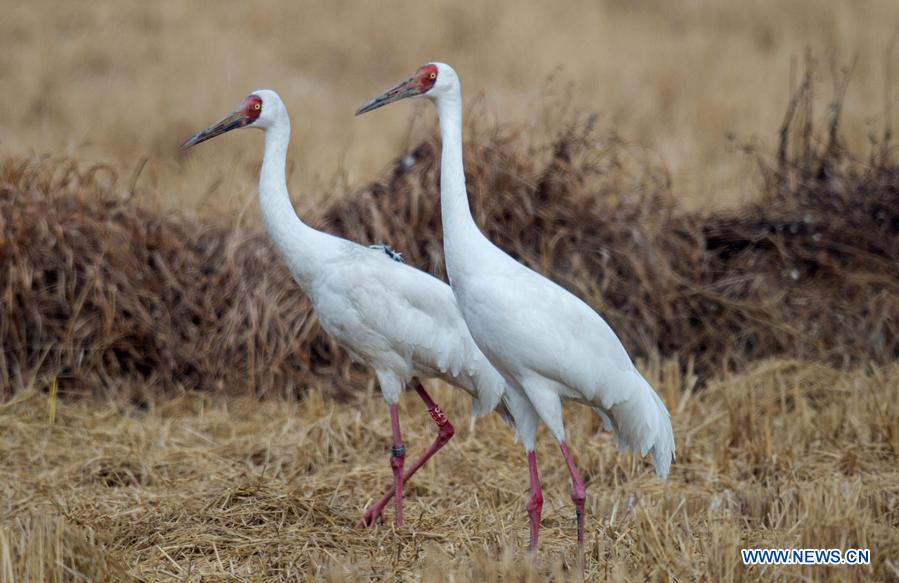
Photo taken by a photographer on Dec. 22, 2018 shows the white crane "Aiai" (L) with a "S26" tag on its leg at the Yellow River Delta National Nature Reserve in east China's Shandong Province. Wang Zhiru, director of the Wildlife Rescue and Breeding Center of Jiangxi Province, and Kuang Shaoxiang, a veterinarian, met the white crane "Aiai" for the first time in April 2018, when it was found and sent to the center by a local villager. "When I first saw it, the crane was so dirty and couldn't even stand steadily due to long-term malnutrition." Wang Zhiru recalled. Bird lovers named the little white crane "Aiai", which means "love" in Chinese. After over 10 days of careful treatment and recuperation, Aiai recovered and could be released into the wild. However, all the other white cranes had left Poyang Lake and moved northward to Momoge National Nature Reserve in northeast China's Jilin Province. White cranes would lose their ability to survive in the wild if they were artificially reared for a long time, so the best choice was to take it to the north and released it at the destination of their migration. Wang Zhiru and Kuang Shaoxiang decided to take Aiai by plane all the way to Jilin Province, to catch up with other white cranes. "We installed a satellite tracker and made a wooden box that met aviation requirements. We also brought it with corn kernels, multivitamin water, and its favorite lotus root. It was like sending our own kid on a long trip." said Kuang Shaoxiang. After a journey of more than 2,000 kilometers from Nanchang to Changchun and then to Momoge National Nature Reserve, Aiai was finally back to the wild. The story of the crane's "family reunion" also attracted lots of attention. Unfortunately, they lost track of Aiai soon as the satellite tracker failed to send back signals, until a photographer accidentally took a picture of Aiai at the Yellow River Delta National Nature Reserve in east China's Shandong Province at the end of 2018. Seeing the "S26" tag on the crane's leg, Wang Zhiru recognized Aiai immediately. "This is Aiai and it proves that Aiai has successfully returned to life in the wild and it even has a mate by its side!" Since then, no one has ever met Aiai again, but Wang Zhiru feels no regret at all. "I'm filled with joy knowing so many people are caring about white cranes, and seeing more and more migratory birds foraging, playing and flying freely at Poyang Lake." Wang Zhiru said. (Xinhua)

Wang Zhiru and Kuang Shaoxiang check the position where the white crane "Aiai" loses connection in the tracing system at the Wildlife Rescue and Breeding Center in east China's Jiangxi Province, Jan. 18, 2021. Wang Zhiru, director of the Wildlife Rescue and Breeding Center of Jiangxi Province, and Kuang Shaoxiang, a veterinarian, met the white crane "Aiai" for the first time in April 2018, when it was found and sent to the center by a local villager. "When I first saw it, the crane was so dirty and couldn't even stand steadily due to long-term malnutrition." Wang Zhiru recalled. Bird lovers named the little white crane "Aiai", which means "love" in Chinese. After over 10 days of careful treatment and recuperation, Aiai recovered and could be released into the wild. However, all the other white cranes had left Poyang Lake and moved northward to Momoge National Nature Reserve in northeast China's Jilin Province. White cranes would lose their ability to survive in the wild if they were artificially reared for a long time, so the best choice was to take it to the north and released it at the destination of their migration. Wang Zhiru and Kuang Shaoxiang decided to take Aiai by plane all the way to Jilin Province, to catch up with other white cranes. "We installed a satellite tracker and made a wooden box that met aviation requirements. We also brought it with corn kernels, multivitamin water, and its favorite lotus root. It was like sending our own kid on a long trip." said Kuang Shaoxiang. After a journey of more than 2,000 kilometers from Nanchang to Changchun and then to Momoge National Nature Reserve, Aiai was finally back to the wild. The story of the crane's "family reunion" also attracted lots of attention. Unfortunately, they lost track of Aiai soon as the satellite tracker failed to send back signals, until a photographer accidentally took a picture of Aiai at the Yellow River Delta National Nature Reserve in east China's Shandong Province at the end of 2018. Seeing the "S26" tag on the crane's leg, Wang Zhiru recognized Aiai immediately. "This is Aiai and it proves that Aiai has successfully returned to life in the wild and it even has a mate by its side!" Since then, no one has ever met Aiai again, but Wang Zhiru feels no regret at all. "I'm filled with joy knowing so many people are caring about white cranes, and seeing more and more migratory birds foraging, playing and flying freely at Poyang Lake." Wang Zhiru said. (Xinhua/Wan Xiang)
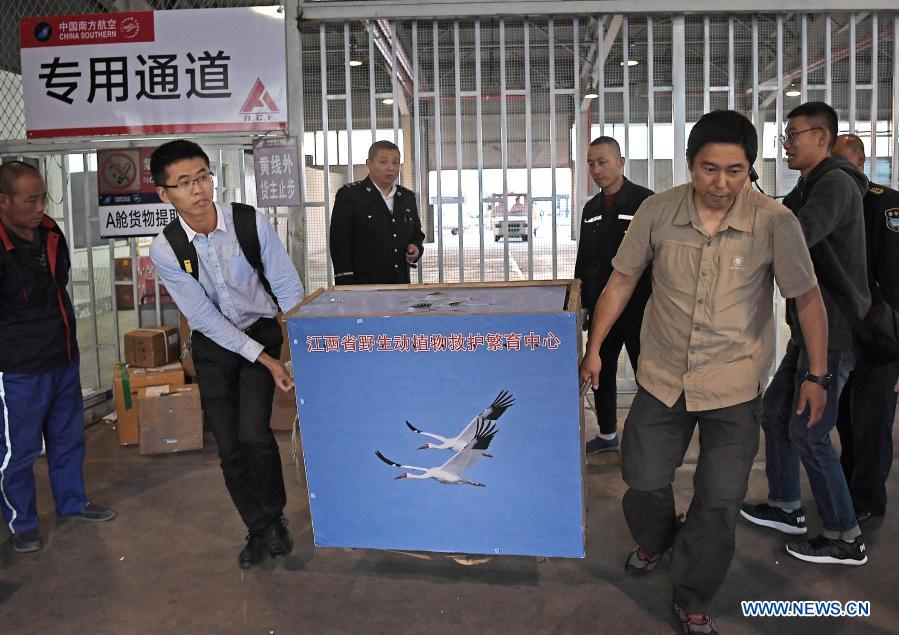
Wang Zhiru (R, front) and Kuang Shaoxiang (L, front) from Jiangxi Wildlife Rescue and Breeding Center transport the white crane "Aiai" to the Longjia Airport in Changchun, northeast China's Jilin Province, May 7, 2018. Wang Zhiru, director of the Wildlife Rescue and Breeding Center of Jiangxi Province, and Kuang Shaoxiang, a veterinarian, met the white crane "Aiai" for the first time in April 2018, when it was found and sent to the center by a local villager. "When I first saw it, the crane was so dirty and couldn't even stand steadily due to long-term malnutrition." Wang Zhiru recalled. Bird lovers named the little white crane "Aiai", which means "love" in Chinese. After over 10 days of careful treatment and recuperation, Aiai recovered and could be released into the wild. However, all the other white cranes had left Poyang Lake and moved northward to Momoge National Nature Reserve in northeast China's Jilin Province. White cranes would lose their ability to survive in the wild if they were artificially reared for a long time, so the best choice was to take it to the north and released it at the destination of their migration. Wang Zhiru and Kuang Shaoxiang decided to take Aiai by plane all the way to Jilin Province, to catch up with other white cranes. "We installed a satellite tracker and made a wooden box that met aviation requirements. We also brought it with corn kernels, multivitamin water, and its favorite lotus root. It was like sending our own kid on a long trip." said Kuang Shaoxiang. After a journey of more than 2,000 kilometers from Nanchang to Changchun and then to Momoge National Nature Reserve, Aiai was finally back to the wild. The story of the crane's "family reunion" also attracted lots of attention. Unfortunately, they lost track of Aiai soon as the satellite tracker failed to send back signals, until a photographer accidentally took a picture of Aiai at the Yellow River Delta National Nature Reserve in east China's Shandong Province at the end of 2018. Seeing the "S26" tag on the crane's leg, Wang Zhiru recognized Aiai immediately. "This is Aiai and it proves that Aiai has successfully returned to life in the wild and it even has a mate by its side!" Since then, no one has ever met Aiai again, but Wang Zhiru feels no regret at all. "I'm filled with joy knowing so many people are caring about white cranes, and seeing more and more migratory birds foraging, playing and flying freely at Poyang Lake." Wang Zhiru said. (Xinhua/Wan Xiang)
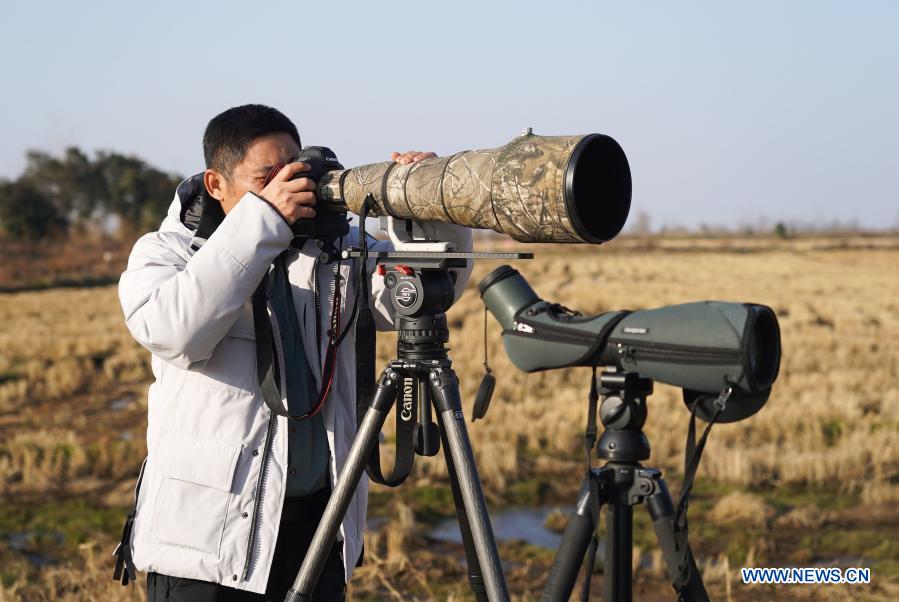
Wang Zhiru takes photos of white cranes in the Kangshan reclamation zone, which serves as one of the birds' wintering habitats near the Poyang Lake, in Yugan County, east China's Jiangxi Province, Jan. 18, 2021. Wang Zhiru, director of the Wildlife Rescue and Breeding Center of Jiangxi Province, and Kuang Shaoxiang, a veterinarian, met the white crane "Aiai" for the first time in April 2018, when it was found and sent to the center by a local villager. "When I first saw it, the crane was so dirty and couldn't even stand steadily due to long-term malnutrition." Wang Zhiru recalled. Bird lovers named the little white crane "Aiai", which means "love" in Chinese. After over 10 days of careful treatment and recuperation, Aiai recovered and could be released into the wild. However, all the other white cranes had left Poyang Lake and moved northward to Momoge National Nature Reserve in northeast China's Jilin Province. White cranes would lose their ability to survive in the wild if they were artificially reared for a long time, so the best choice was to take it to the north and released it at the destination of their migration. Wang Zhiru and Kuang Shaoxiang decided to take Aiai by plane all the way to Jilin Province, to catch up with other white cranes. "We installed a satellite tracker and made a wooden box that met aviation requirements. We also brought it with corn kernels, multivitamin water, and its favorite lotus root. It was like sending our own kid on a long trip." said Kuang Shaoxiang. After a journey of more than 2,000 kilometers from Nanchang to Changchun and then to Momoge National Nature Reserve, Aiai was finally back to the wild. The story of the crane's "family reunion" also attracted lots of attention. Unfortunately, they lost track of Aiai soon as the satellite tracker failed to send back signals, until a photographer accidentally took a picture of Aiai at the Yellow River Delta National Nature Reserve in east China's Shandong Province at the end of 2018. Seeing the "S26" tag on the crane's leg, Wang Zhiru recognized Aiai immediately. "This is Aiai and it proves that Aiai has successfully returned to life in the wild and it even has a mate by its side!" Since then, no one has ever met Aiai again, but Wang Zhiru feels no regret at all. "I'm filled with joy knowing so many people are caring about white cranes, and seeing more and more migratory birds foraging, playing and flying freely at Poyang Lake." Wang Zhiru said. (Xinhua/Wan Xiang)
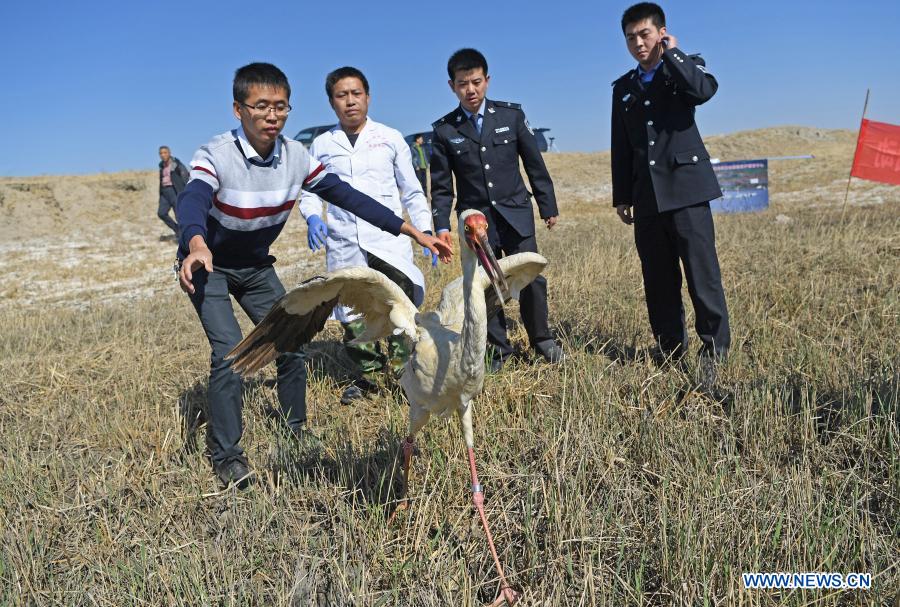
Kuang Shaoxiang (1st L, front) releases the white crane "Aiai" at Momoge National Nature Reserve in northeast China's Jilin Province, May 8, 2018. Wang Zhiru, director of the Wildlife Rescue and Breeding Center of Jiangxi Province, and Kuang Shaoxiang, a veterinarian, met the white crane "Aiai" for the first time in April 2018, when it was found and sent to the center by a local villager. "When I first saw it, the crane was so dirty and couldn't even stand steadily due to long-term malnutrition." Wang Zhiru recalled. Bird lovers named the little white crane "Aiai", which means "love" in Chinese. After over 10 days of careful treatment and recuperation, Aiai recovered and could be released into the wild. However, all the other white cranes had left Poyang Lake and moved northward to Momoge National Nature Reserve in northeast China's Jilin Province. White cranes would lose their ability to survive in the wild if they were artificially reared for a long time, so the best choice was to take it to the north and released it at the destination of their migration. Wang Zhiru and Kuang Shaoxiang decided to take Aiai by plane all the way to Jilin Province, to catch up with other white cranes. "We installed a satellite tracker and made a wooden box that met aviation requirements. We also brought it with corn kernels, multivitamin water, and its favorite lotus root. It was like sending our own kid on a long trip." said Kuang Shaoxiang. After a journey of more than 2,000 kilometers from Nanchang to Changchun and then to Momoge National Nature Reserve, Aiai was finally back to the wild. The story of the crane's "family reunion" also attracted lots of attention. Unfortunately, they lost track of Aiai soon as the satellite tracker failed to send back signals, until a photographer accidentally took a picture of Aiai at the Yellow River Delta National Nature Reserve in east China's Shandong Province at the end of 2018. Seeing the "S26" tag on the crane's leg, Wang Zhiru recognized Aiai immediately. "This is Aiai and it proves that Aiai has successfully returned to life in the wild and it even has a mate by its side!" Since then, no one has ever met Aiai again, but Wang Zhiru feels no regret at all. "I'm filled with joy knowing so many people are caring about white cranes, and seeing more and more migratory birds foraging, playing and flying freely at Poyang Lake." Wang Zhiru said. (Xinhua/Wan Xiang)
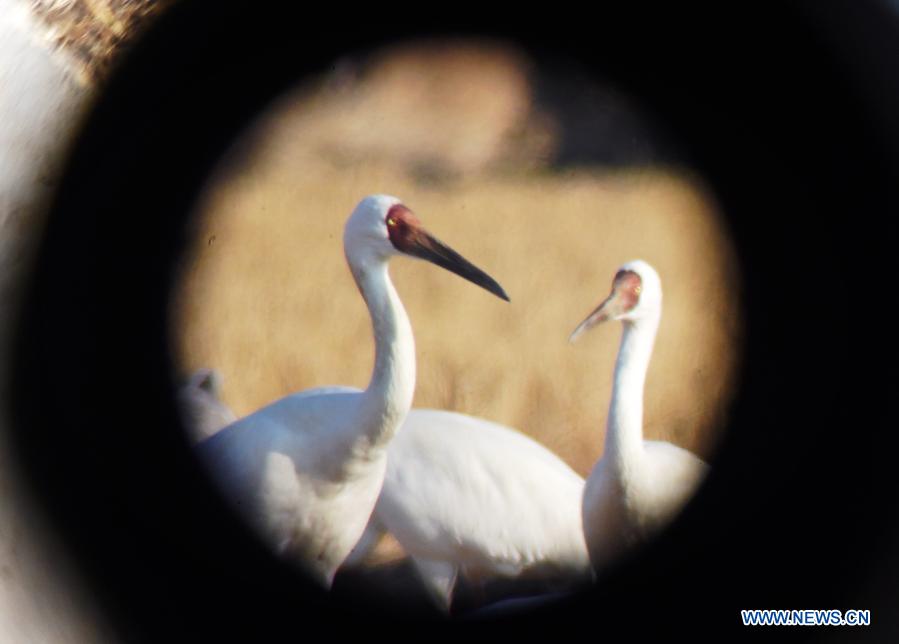
Photo taken on Jan. 18, 2021 through a telescope shows white cranes in the Kangshan reclamation zone, which serves as one of the birds' wintering habitats near the Poyang Lake, in Yugan County, east China's Jiangxi Province. Wang Zhiru, director of the Wildlife Rescue and Breeding Center of Jiangxi Province, and Kuang Shaoxiang, a veterinarian, met the white crane "Aiai" for the first time in April 2018, when it was found and sent to the center by a local villager. "When I first saw it, the crane was so dirty and couldn't even stand steadily due to long-term malnutrition." Wang Zhiru recalled. Bird lovers named the little white crane "Aiai", which means "love" in Chinese. After over 10 days of careful treatment and recuperation, Aiai recovered and could be released into the wild. However, all the other white cranes had left Poyang Lake and moved northward to Momoge National Nature Reserve in northeast China's Jilin Province. White cranes would lose their ability to survive in the wild if they were artificially reared for a long time, so the best choice was to take it to the north and released it at the destination of their migration. Wang Zhiru and Kuang Shaoxiang decided to take Aiai by plane all the way to Jilin Province, to catch up with other white cranes. "We installed a satellite tracker and made a wooden box that met aviation requirements. We also brought it with corn kernels, multivitamin water, and its favorite lotus root. It was like sending our own kid on a long trip." said Kuang Shaoxiang. After a journey of more than 2,000 kilometers from Nanchang to Changchun and then to Momoge National Nature Reserve, Aiai was finally back to the wild. The story of the crane's "family reunion" also attracted lots of attention. Unfortunately, they lost track of Aiai soon as the satellite tracker failed to send back signals, until a photographer accidentally took a picture of Aiai at the Yellow River Delta National Nature Reserve in east China's Shandong Province at the end of 2018. Seeing the "S26" tag on the crane's leg, Wang Zhiru recognized Aiai immediately. "This is Aiai and it proves that Aiai has successfully returned to life in the wild and it even has a mate by its side!" Since then, no one has ever met Aiai again, but Wang Zhiru feels no regret at all. "I'm filled with joy knowing so many people are caring about white cranes, and seeing more and more migratory birds foraging, playing and flying freely at Poyang Lake." Wang Zhiru said. (Xinhua/Wan Xiang)








